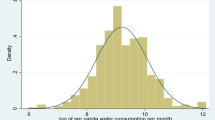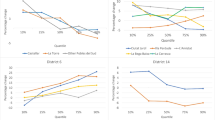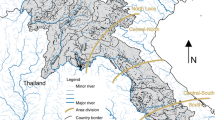Abstract
Water expenditures variable, as the primary indicator of water consumption, is primordial to analysing and designing water policies. Numerous studies have analyzed water expenditures by considering various factors, including social, spatial, and climate variables predominantly relying on modeling tools often perceived as “black boxes”. In this study, we adopt a different approach, employing D-vine copula quantile regression to scrutinize water expenditures. This method has been proven to be efficient in predicting quantiles for different areas, especially when the normality assumption is inappropriate. Indeed, vine copulas offer the flexibility to select different marginal distributions and a variety of dependence structures. An illustration of the proposed methodology is applied to water consumption in Morocco. The results show different relationships between water expenditures and a set of determinant factors (geographical Area, Sex, and Educational level of the householder), they also show the quantiles’ variability at the regional scale.







Similar content being viewed by others
Availability of data and materials
Data are available from the Public Microdata File of the National Survey concerning Household Consumption and Expenditures conducted by the Morrocan High Commission for Planning in 2014 (see Haut Commissariat au Plan (HCP) (2014)). The R code used to generate models, results and graphs is available from the corresponding author upon request.
References
Aas K, Czado C, Frigessi A et al (2009) Pair-copula constructions of multiple dependence. Insur Math Econ 44(2):182–198
Arbués F, Garcıa-Valiñas MÁ, Martınez-Espiñeira R (2003) Estimation of residential water demand: a state-of-the-art review. J Socio-Econ 32(1):81–102
Bao K, Padsala R, Thrän D et al (2020) Urban water demand simulation in residential and non-residential buildings based on a citygml data model. ISPRS Int J Geo-inf 9(11):642
Bedford T, Cooke RM (2001) Probability density decomposition for conditionally dependent random variables modeled by vines. Ann Math Artif Intell 32(1–4):245–268
Bedford T, Cooke RM (2002) Vines: a new graphical model for dependent random variables. Ann Stat 1031–1068
Bich-Ngoc N, Teller J (2018) A review of residential water consumption determinants. In: Computational science and its applications–ICCSA 2018: 18th International Conference, Melbourne, VIC, Australia, July 2-5, 2018, Proceedings, Part V 18, Springer, pp 685–696
Cheng Z, He J, Liu Y et al (2023) Exploring the spatial structure and impact factors of water use efficiency in China. Environ Impact Assess Rev 103:107258
Dalhuisen JM, Florax RJ, De Groot HL et al (2003) Price and income elasticities of residential water demand: a meta-analysis. Land Econ 79(2):292–308
Deger IH, Esıt M, Yuce MI (2023) Univariate and bivariate hydrological drought frequency analysis by copula functions. Water Resour Manag 37(12):4881–4907
del Villar A, Melgarejo J (2020) Prospective models for water service demand and price analyses. Water 12(6):1613
Dissmann J, Brechmann EC, Czado C et al (2013) Selecting and estimating regular vine copulae and application to financial returns. Comput Stat Data Anal 59:52–69
El Adlouni S (2018) Quantile regression c-vine copula model for spatial extremes. Nat Hazards 94(1):299–317
El Hannoun W, El Adlouni SE, Zoglat A (2021) Vine-copula-based quantile regression for cascade reservoirs management. Water 13(7):964
El Hannoun W, Boukili Makhoukhi A, Zoglat A et al (2023) Intensity-duration-frequency curves for dependent datasets. Water 15(14):2641
Guercio R, Magini R, Pallavicini I (1970) Instantaneous residential water demand as stochastic point process. WIT Trans Ecol Environ 48
Haut Commissariat au Plan (HCP) (2014) Enquête Nationale sur la Consommation et les Dépenses des Ménages (ENCDM)
Kostas B, Chrysostomos S (2006) Estimating urban residential water demand determinants and forecasting water demand for athens metropolitan area, 2000-2010. South-Eastern Europe Journal of Economics 4(1)
Kraus D, Czado C (2017) D-vine copula based quantile regression. Comput Stat Data Anal 110:1–18
Latif S, Simonovic SP (2023) Trivariate probabilistic assessments of the compound flooding events using the 3-d fully nested archimedean (fna) copula in the semiparametric distribution setting. Water Resour Manag 37(4):1641–1693
Ma JR, NR C (2023) Application of copulas in hydrometeorological drought risk analysis under climate change scenarios-a case study. Water Resour Manag 37(14):5399–5429
Mangalekar R, Gumaste K (2021) Residential water demand modelling and hydraulic reliability in design of building water supply systems: a review. Water Supply 21(4):1385–1397
Motevali Bashi Naeini E, Akhoond-Ali AM, Radmanesh F et al (2021) Comparison of the calculated drought return periods using tri-variate and bivariate copula functions under climate change condition. Water Resour Manag 35:4855–4875
Mu X, Whittington D, Briscoe J (1990) Modeling village water demand behavior: a discrete choice approach. Water Resour Res 26(4):521–529
Nagler T, Kraus D (2019) vinereg: D-vine quantile regression. R package version 070
Rosenblatt M (1952) Remarks on a multivariate transformation. Ann Math Stat 23(3):470–472
Schepsmeier U (2015) Efficient information based goodness-of-fit tests for vine copula models with fixed margins: a comprehensive review. J Multivar Anal 138:34–52
Schleich J, Hillenbrand T (2009) Determinants of residential water demand in germany. Ecol Econ 68(6):1756–1769
Sklar M (1959) Fonctions de répartition à n dimensions et leurs marges. In: Annales de l’ISUP, pp 229–231
Taher S, Alsaati A (2002) Cross sectional analysis of residential water consumption in the city of riyadh. Wat Eng Res Int J KWRA 3(4):269–278
Tepegjozova M, Zhou J, Claeskens G et al (2022) Nonparametric c-and d-vine-based quantile regression. Depend Model 10(1):1–21
Termes-Rife M, Bernardo V (2015) Water demand models. University of Barcelona
Worthington AC, Hoffman M (2008) An empirical survey of residential water demand modelling. J Econ Surv 22(5):842–871
Worthington A, Hoffman M (2007) A state of the art review of residential water demand modelling, School of Accounting & Finance, University of Wollongong. Tech. rep., Working Paper 6
Xie K, He Y, Kim JS et al (2023) Assessment of the joint impact of rainfall characteristics on urban flooding and resilience using the copula method. Water Resour Manag 37(4):1765–1784
Zhao Y, Guo L, Li Y et al (2023) Revealing the driving factors for structure changes of regional water consumption: an empirical study of the middle route project of the south-to-north water diversion in China. Environ Dev Sustain 1–24
Acknowledgements
The authors would like to thank the Editor and the Reviewers for their time and comments that helped improve the manuscript. The authors would also like to thank Samuel Leclerc, a student at the Université de Moncton, for the English language editing.
Funding
This research was supported by the PPR2 8/2016 program, a Moroccan government program to support scientific research.
Author information
Authors and Affiliations
Contributions
W.E.H.: Conceptualization, Methodology, Investigation, Data curation, Formal Analysis, Writing - Original Draft. A.Z.: Conceptualization, Methodology, Writing & Review. E. E.: Conceptualization, Methodology, Writing & Review. S.-E.E.A.: Methodology, Writing & Review.
Corresponding author
Ethics declarations
Ethical approval
Not applicable.
Consent to participate
Not applicable.
Consent to publish
Not applicable.
Competing interests
No potential conflict of interest was reported by the authors.
Additional information
Publisher's Note
Springer Nature remains neutral with regard to jurisdictional claims in published maps and institutional affiliations.
Rights and permissions
Springer Nature or its licensor (e.g. a society or other partner) holds exclusive rights to this article under a publishing agreement with the author(s) or other rightsholder(s); author self-archiving of the accepted manuscript version of this article is solely governed by the terms of such publishing agreement and applicable law.
About this article
Cite this article
Wafaa, E.H., Abdelhak, Z., ElHadj, E. et al. D-vine Copula Quantile Regression for a Multidimensional Water Expenditures Analysis: Social and Regional Impacts. Water Resour Manage (2024). https://doi.org/10.1007/s11269-024-03813-z
Received:
Accepted:
Published:
DOI: https://doi.org/10.1007/s11269-024-03813-z




